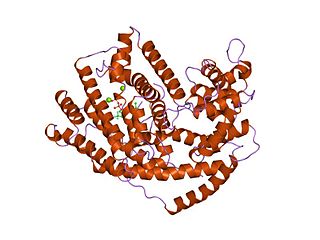Gibberellins (GAs) are plant hormones that regulate various developmental processes, including stem elongation, germination, dormancy, flowering, flower development, and leaf and fruit senescence. GAs are one of the longest-known classes of plant hormone. It is thought that the selective breeding of crop strains that were deficient in GA synthesis was one of the key drivers of the "green revolution" in the 1960s, a revolution that is credited to have saved over a billion lives worldwide.
In enzymology, a copalyl diphosphate synthase is an enzyme that catalyzes the chemical reaction
In enzymology, an ent-copalyl diphosphate synthase is an enzyme that catalyzes the chemical reaction:
The enzyme abieta-7,13-diene synthase catalyzes the chemical reaction
The enzyme ent-kaurene synthase catalyzes the chemical reaction

Momilactone B is an allelopathic agent produced from the roots of rice. It has been shown to be produced in high concentrations by the roots of rice seedlings. The production of momilactone B has also been induced in response to infection by blast fungus or irradiated with UV light. More recently it has been shown to be a potential chemotherapeutic agent against human colon cancer.

In molecular biology, this protein domain belongs to the terpene synthase family (TPS). Its role is to synthesize terpenes, which are part of primary metabolism, such as sterols and carotene, and also part of the secondary metabolism. This entry will focus on the N terminal domain of the TPS protein.

In molecular biology, this protein domain belongs to the terpene synthase family (TPS). Its role is to synthesize terpenes, which are part of primary metabolism, such as sterols and carotene, and also part of the secondary metabolism. This entry will focus on the C terminal domain of the TPS protein.
Isoeugenol synthase (EC 1.1.1.319, IGS1, t-anol/isoeugenol synthase 1) is an enzyme with systematic name eugenol:NADP+ oxidoreductase (coniferyl acetate reducing). This enzyme catalyses the following chemical reaction.
ent-Cassa-12,15-diene synthase is an enzyme with systematic name ent-copalyl-diphosphate diphosphate-lyase (ent-cassa-12,15-diene-forming). This enzyme catalyses the following chemical reaction
ent-Sandaracopimaradiene synthase is an enzyme with systematic name ent-copalyl-diphosphate diphosphate-lyase [ent-sandaracopimara-8(14),15-diene-forming]. This enzyme catalyses the following chemical reaction
Stemar-13-ene synthase is an enzyme with systematic name 9α-copalyl-diphosphate diphosphate-lyase (stemar-13-ene-forming). This enzyme catalyses the following chemical reaction
Stemod-13(17)-ene synthase is an enzyme with systematic name 9α-copalyl-diphosphate diphosphate-lyase . This enzyme catalyses the following chemical reaction
syn-Pimara-7,15-diene synthase is an enzyme with systematic name 9α-copalyl-diphosphate diphosphate-lyase (9β-pimara-7,15-diene-forming). This enzyme catalyses the following chemical reaction
(+)-α-Barbatene synthase is an enzyme with systematic name (2E,6E)-farnesyl-diphosphate diphosphate-lyase ( -α-barbatene-forming). This enzyme catalyses the following chemical reaction
Valencene synthase is an enzyme with systematic name (2E,6E)-farnesyl-diphosphate diphosphate-lyase (valencene-forming). It is a terpene cyclase enzyme responsible for the biosynthesis of valencene, a sesquiterpene, using farnesyl pyrophosphate as its substrate. The first such enzyme was isolated using orange cDNA. This enzyme catalyses the following chemical reaction
(+)-Car-3-ene synthase is an enzyme with systematic name geranyl-diphosphate diphosphate-lyase [cyclizing, (+)-car-3-ene-forming]. This enzyme catalyses the following chemical reaction
β-Sesquiphellandrene synthase is an enzyme with systematic name (2E,6E)-farnesyl-diphosphate diphosphate-lyase . This enzyme catalyses the following chemical reaction
cis-Abienol synthase is an enzyme with systematic name (13E)-8α-hydroxylabd-13-en-15-yl-diphosphate-lyase . This enzyme catalyses the following chemical reaction

Pisatin (3-hydroxy-7-methoxy-4′,5′-methylenedioxy-chromanocoumarane) is the major phytoalexin made by the pea plant Pisum sativum. It was the first phytoalexin to be purified and chemically identified. The molecular formula is C17H14O6.




